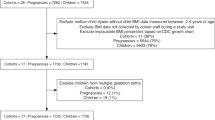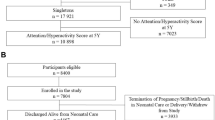Abstract
Background
To identify modifiable antecedents during pre-pregnancy and pregnancy windows associated with a positive child health at 10 years of age.
Methods
Data on 889 children enrolled in the Extremely Low Gestational Age Newborn (ELGAN) study in 2002–2004 were analyzed for associations between potentially modifiable maternal antecedents during pre-pregnancy and pregnancy time windows and a previously described positive child health index (PCHI) score at 10 years of age. Stratification by race was also investigated for associations with investigated antecedents.
Results
Factors associated with higher PCHI (more positive health) included greater gestational age, birth weight, multiple gestation, and medical interventions, including assisted reproduction and cervical cerclage. Factors associated with lower PCHI included correlates of lower socioeconomic status, pre-pregnancy chronic medical disorders in the mother such as pre-pregnancy body mass index (BMI), and maternal asthma. When stratified by race, variation in significant results was observed.
Conclusions
Among children born extremely preterm, medical interventions and higher socioeconomic status were associated with improved PCHI, while chronic illness and high BMI in the mother is associated with lower PCHI at 10 years of age. Knowledge of such antecedent factors could inform efforts to develop interventions that promote positive child health outcomes in future pregnancies.
Similar content being viewed by others
Log in or create a free account to read this content
Gain free access to this article, as well as selected content from this journal and more on nature.com
or
References
Anderson, P. J. Neuropsychological outcomes of children born very preterm. Semin. Fetal Neonatal Med. 19, 90–96 (2014).
Linsell, L., Malouf, R., Morris, J., Kurinczuk, J. J. & Marlow, N. Prognostic factors for poor cognitive development in children born very preterm or with very low birth weight: a systematic review. JAMA Pediatr. 169, 1162–1172 (2015).
Heeren, T. et al. Cognitive functioning at the age of 10 years among children born extremely preterm: a latent profile approach. Pediatr. Res. 82, 614–619 (2017).
Joseph, R. M. et al. Prevalence and associated features of autism spectrum disorder in extremely low gestational age newborns at age 10 years. Autism Res. 10, 224–232 (2017).
Douglass, L. M. et al. Cumulative incidence of seizures and epilepsy in ten-year-old children born before 28 weeks’ gestation. Pediatr. Neurol. 73, 13–19 (2017).
Kuban, K. C. et al. Cranial ultrasound lesions in the NICU predict cerebral palsy at age 2 years in children born at extremely low gestational age. J. Child Neurol. 24, 63–72 (2009).
Kuban, K. C. et al. Girls and boys born before 28 weeks gestation: Risks of cognitive, behavioral, and neurologic outcomes at age 10 years. J. Pediatr. 173, 69–75. e61 (2016).
Bangma, J. T. et al. Assessing positive child health among individuals born extremely preterm. J. Pediatr. 202, 44–49.e4 (2018).
Von Elm, E. et al. The Strengthening the Reporting of Observational Studies in Epidemiology (STROBE) statement: guidelines for reporting observational studies. PLoS Med. 4, e296 (2007).
Yudkin, P. L., Aboualfa, M., Eyre, J. A., Redman, C. W. & Wilkinson, A. R. New birthweight and head circumference centiles for gestational ages 24 to 42 weeks. Early Hum. Dev. 15, 45–52 (1987).
Leviton, A. et al. Maternal infection, fetal inflammatory response, and brain damage in very low birth weight infants. Pediatr. Res. 46, 566–566 (1999).
Bright, H. R. et al. Neurocognitive outcomes at 10 years of age in extremely preterm newborns with late-onset bacteremia. J. Pediatr. 187, 43–49 (2017).
Scott, M. N. et al. Neurocognitive correlates of attention-deficit hyperactivity disorder symptoms in children born at extremely low gestational age. J. Dev. Behav. Pediatr. 38, 249–259 (2017).
Joseph, R. M., O’Shea, T. M., Allred, E. N., Heeren, T. & Kuban, K. K. Maternal educational status at birth, maternal educational advancement, and neurocognitive outcomes at age 10 years among children born extremely preterm. Pediatr. Res. 83, 767 (2018).
Logan, J. W. et al. Neurocognitive function of 10 year-old multiples born extremely preterm. J. Perinatol. 39, 237–247 (2019).
Jackson, W. M. et al. Risk factors for chronic lung disease and asthma differ among children born extremely preterm. Pediatr. Pulmonol. 53, 1533–1540 (2018).
Wood, C. T. et al. Antecedents of obesity among children born extremely preterm. Pediatrics 142, e20180519 (2018).
van der Burg, J. W. et al. The role of systemic inflammation linking maternal BMI to neurodevelopment in children. Pediatr. Res. 79, 3 (2015).
van der Burg, J. W. et al. Are extremely low gestational age newborns born to obese women at increased risk of cerebral palsy at 2 years? J. child Neurol. 33, 216–224 (2018).
van der Burg, J. W. et al. Maternal obesity and attention-related symptoms in the preterm offspring. Early Hum. Dev. 115, 9–15 (2017).
Kuban, K. C. et al. Systemic inflammation and cerebral palsy risk in extremely preterm infants. J. Child Neurol. 29, 1692–1698 (2014).
Allred, E. N. et al. Systemic inflammation during the first postnatal month and the risk of attention deficit hyperactivity disorder characteristics among 10 year-old children born extremely preterm. J. Neuroimmune Pharmacol. 12, 531–543 (2017).
Meakin, A. S. et al. Review: placental adaptations to the presence of maternal asthma during pregnancy. Placenta 54, 17–23 (2017).
Murphy, V. et al. The risk of congenital malformations, perinatal mortality and neonatal hospitalisation among pregnant women with asthma: a systematic review and meta-analysis. BJOG Int. J. Obstet. Gynaecol. 120, 812–822 (2013).
Yessoufou, A. & Moutairou, K. Maternal diabetes in pregnancy: early and long-term outcomes on the offspring and the concept of “metabolic memory”. Exp. Diabetes Res. 2011, 218598 (2011).
Stokholm, J. et al. Prevalence and predictors of antibiotic administration during pregnancy and birth. PLoS ONE 8, e82932 (2013).
Phibbs, C. S. & Schmitt, S. K. Estimates of the cost and length of stay changes that can be attributed to one-week increases in gestational age for premature infants. Early Hum. Dev. 82, 85–95 (2006).
Spittle, A., Orton, J., Anderson, P. J., Boyd, R. & Doyle, L. W. Early developmental intervention programmes provided post hospital discharge to prevent motor and cognitive impairment in preterm infants. Cochrane Database Syst. Rev. 11, 3–4 (2015).
Byerley, B. M. & Haas, D. M. A systematic overview of the literature regarding group prenatal care for high-risk pregnant women. BMC Pregnancy Childbirth 17, 329 (2017).
Williamson, G. R., O’Connor, A. & Kayleigh, E. J. Women’s experiences of personalised support for asthma care during pregnancy: A systematic review of the literature. BMC Pregnancy Childbirth 17, 69 (2017).
Yeo, S., Walker, J. S., Caughey, M. C., Ferraro, A. M. & Asafu-Adjei, J. K. What characteristics of nutrition and physical activity interventions are key to effectively reducing weight gain in obese or overweight pregnant women? A systematic review and meta-analysis. Obes. Rev. 18, 385–399 (2017).
Acknowledgments
We gratefully acknowledge the contributions of the ELGAN subjects the ELGAN subjects’ families, as well as the colleagues listed below. This study was supported by grants from the National Institute of Neurological Disorders and Stroke (5U01NS040069-05; 2R01NS040069-06A2), the National Institute of Child Health and Human Development (5R01HD092374-02 and 5P30HD018655-34), the Office of the NIH Director (1UG3OD023348-01), NIH training grant (T32-ES007018), and National Institute of Nursing Research (1K23NR017898-01).
ELGAN-2 Members
Project Lead for ELGAN-2: Julie V. Rollins, MA.
Site Principal Investigators
Baystate Medical Center, Springfield, MA: Bhahvesh Shah, MD; Rachana Singh, MD, MS. Boston Children’s Hospital, Boston, MA: Linda Van Marter, MD, MPH and Camilla Martin, MD, MPH; Janice Ware, Ph.D. Tufts Medical Center, Boston, MA: Cynthia Cole, MD; Ellen Perrin, MD. University of Massachusetts Medical School, Worcester, MA: Frank Bednarek, MD; Jean Frazier, MD. Yale University School of Medicine, New Haven, CT: Richard Ehrenkranz, MD; Jennifer Benjamin, MD. Wake Forest University, Winston-Salem, NC: T. Michael O’Shea, MD, MPH. Wake Forest University, Winston-Salem, NC: T. Michael O’Shea, MD, MPH. University of North Carolina, Chapel Hill, NC: Carl Bose, MD; Diane Warner, MD, MPH. East Carolina University, Greenville, NC: Steve Engelke, MD. Helen DeVos Children’s Hospital, Grand Rapids, MI: Mariel Poortenga, MD; Steve Pastyrnak, Ph.D. Sparrow Hospital, East Lansing, MI: Padu Karna, MD; Nigel Paneth, MD, MPH; Madeleine Lenski, MPH. University of Chicago Medical Center, Chicago, IL: Michael Schreiber, MD; Scott Hunter, Ph.D; Michael Msall, MC. William Beaumont Hospital, Royal Oak, MI: Danny Batton, MD; Judith Klarr, MD.
Site Study Coordinators
Baystate Medical Center, Springfield, MA: Karen Christianson, RN; Deborah Klein, BSM, RN. Boston Children’s Hospital, Boston MA: Maureen Pimental, BA; Collen Hallisey, BA; Taryn Coster, BA. Tufts Medical Center, Boston, MA: Ellen Nylen, RN; Emily Neger, MA; Kathryn Mattern, BA. University of Massachusetts Medical School, Worcester, MA: Lauren Venuti, BA; Beth Powers, RN; Ann Foley, EdM. Yale University School of Medicine, New Haven, CT: Joanne Williams, RN; Elaine Romano, APRN. Wake Forest University, Winston-Salem, NC: Debbie Hiatt, BSN (deceased); Nancy Peters, RN; Patricia Brown, RN; Emily Ansusinha, BA. University of North Carolina, Chapel Hill, NC: Gennie Bose, RN; Janice Wereszczak, MSN; Janice Bernhardt, MS, RN. East Carolina University, Greenville, NC: Joan Adams (deceased); Donna Wilson, BA, BSW. Nancy Darden-Saad, BS, RN. Helen DeVos Children’s Hospital, Grand Rapids, MI: Dinah Sutton, RN; Julie Rathbun, BSW, BSN. Sparrow Hospital, East Lansing, MI: Karen Miras, RN, BSN; Deborah Weiland, MSN. University of Chicago Medical Center, Chicago, IL: Grace Yoon, RN; Rugile Ramoskaite, BA; Suzanne Wiggins, MA; Krissy Washington, MA; Ryan Martin, MA; Barbara Prendergast, BSN, RN. William Beaumont Hospital, Royal Oak, MI: Beth Kring, RN.
Psychologists
Baystate Medical Center, Springfield, MA: Anne Smith, Ph.D.; Susan McQuiston, Ph.D. Boston Children’s Hospital: Samantha Butler, Ph.D.; Rachel Wilson, Ph.D.; Kirsten McGhee, Ph.D.; Patricia Lee, Ph.D.; Aimee Asgarian, Ph.D.; Anjali Sadhwani, Ph.D.; Brandi Henson, PsyD. Tufts Medical Center, Boston MA: Cecelia Keller, PT, MHA; Jenifer Walkowiak, Ph.D.; Susan Barron, Ph.D. University of Massachusetts Medical School, Worcester MA: Alice Miller, PT, MS; Brian Dessureau, Ph.D.; Molly Wood, Ph.D.; Jill Damon-Minow, Ph.D. Yale University School of Medicine, New Haven, CT: Elaine Romano, MSN; Linda Mayes, Ph.D.; Kathy Tsatsanis, Ph.D.; Katarzyna Chawarska, Ph.D.; Sophy Kim, Ph.D.; Susan Dieterich, Ph.D.; Karen Bearrs, Ph.D. Wake Forest University Baptist Medical Center, Winston-Salem NC: Ellen Waldrep, MA; Jackie Friedman, Ph.D.; Gail Hounshell, Ph.D.; Debbie Allred, Ph.D. University Health Systems of Eastern Carolina, Greenville, NC: Rebecca Helms, Ph.D.; Lynn Whitley, Ph.D. Gary Stainback, Ph.D. University of North Carolina at Chapel Hill, NC: Lisa Bostic, OTR/L; Amanda Jacobson, PT; Joni McKeeman, Ph.D.; Echo Meyer, Ph.D. Helen DeVos Children’s Hospital, Grand Rapids, MI: Steve Pastyrnak, Ph.D. Sparrow Hospital, Lansing, MI: Joan Price, EdS; Megan Lloyd, MA, EdS. University of Chicago Medical Center, Chicago, IL: Susan Plesha-Troyke, OT; Megan Scott, Ph.D. William Beaumont Hospital, Royal Oak, MI: Katherine M. Solomon, Ph.D.; Kara Brooklier, Ph.D.; Kelly Vogt, Ph.D.
Author information
Authors and Affiliations
Consortia
Contributions
All authors listed on this manuscript contributed to all three types of substantial contributions listed in Pediatric Research instructions to authors. Bi-weekly conference calls were held throughout the processes of brainstorming, method development, writing, and reviewing of this manuscript in which all authors participated.
Corresponding author
Ethics declarations
Competing interests
The authors declare no competing interests.
Additional information
Publisher’s note: Springer Nature remains neutral with regard to jurisdictional claims in published maps and institutional affiliations.
Members of the ELGAN study are given below the Acknowledgments.
Supplementary information
Rights and permissions
About this article
Cite this article
Bangma, J.T., Kwiatkowski, E., Psioda, M. et al. Early life antecedents of positive child health among 10-year-old children born extremely preterm. Pediatr Res 86, 758–765 (2019). https://doi.org/10.1038/s41390-019-0404-x
Received:
Revised:
Accepted:
Published:
Issue date:
DOI: https://doi.org/10.1038/s41390-019-0404-x
This article is cited by
-
Child and family factors associated with positive outcomes among youth born extremely preterm
Pediatric Research (2023)
-
Environmental influences on child health outcomes: cohorts of individuals born very preterm
Pediatric Research (2023)
-
Placental programming, perinatal inflammation, and neurodevelopment impairment among those born extremely preterm
Pediatric Research (2021)
-
Families’ perspectives on monitoring infants’ health and development after discharge from NICUs
Pediatric Research (2021)
-
Psychosocial and medical adversity associated with neonatal neurobehavior in infants born before 30 weeks gestation
Pediatric Research (2020)



